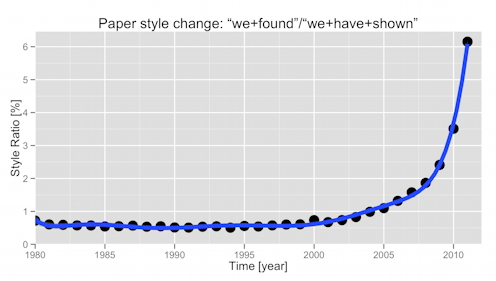
Well, the title may be a bit too grandiose, but my little investigation may surprise you too.
When I read a paper stating “We were able to show…” I cringe (and I delete it from any papers I co-author). To simplify, there are two ways to do science. Approach A is to “… perceive whatever holds / The world together in its inmost folds”, approach B: “look how much work/ingenuity I have invested / impact factor harvested / publications put out / recognition earned” (yes I said it’s simplified ;-). So for me approach A is typified by “We found…”, while approach B is revealed by “We were able to show…”. Now I know myself – I can go overboard with my opinions. So in my last sleepless night it occurred to me to look whether my feeling that everyone these days is “able to show / demonstrate…” is just my obsession or based on actual fact. So I went to Google Scholar, where it is easy to narrow searches to time ranges, and compared the number of occurrences of “we found” versus “we were able to show”.
Based on a quick web query I learned the term “web scraper” and built a simple one to extract the number of results. [This is “iffed out” in the code below, since it banned me after a few tries – see comments on “scraping” Google Scholar; ideas?]
Amazingly: the ratio of “we could show” over “we found” changed from 0.5–0.7% in 1980–2000 to 6% in 2011, a 8th(!) order polynom being necessary to model the steep rise by a factor of 10 in the last ≈5 years!
There’s lots to be argued – is the wording I chose adequate, is it occasionally ok to say “we could show…” (yes), why I started 1980, and and… This post is already too long. Finally, here’s the code, and I would love to learn how to improve (e.g. get rid of the for loop) and how to avoid a Google ban (which shows up as “this page has moved”).
Code Begin
#
looking for a style change in scientific papers over time
#
© 2012-08-05 Michael Bach
«a href=”https://michaelbach.de”>https://michaelbach.de</a>> michael.bach@uni-freiburg.de
#
a simple scholar scraper
googleScholarHits <- function(searchString, yearStart, yearEnd) {
require(RCurl)
url = paste0("<a href="http://scholar.google.com/scholar?as_ylo=">http://scholar.google.com/scholar?as_ylo=</a>",
as.character(yearStart), "&as_yhi=", as.character(yearEnd),
"&q=%22", searchString, "%22&hl=en&num=1&as_sdt=0")
print(url)
webpage = as.character(getURL(url))
print(substr(webpage, 1, 500))
require(stringr)
start = str_locate(webpage, fixed(">About "))[2]
end = str_locate(webpage, fixed(" results ("))[1]
number = substr(webpage, start, end)
return(as.numeric(sub(pattern=",", replacement="", x=number)))
}
style1string=”we+found”; style2string=”we+have+shown”
googleScholarHits(style1string, 2009, 2009) # a manual test
years = seq(from=1980, to=2011, by=1)
if (FALSE) {
nStyle1 = array(); nStyle2 = array(); i = 1
for (year in years) {
nStyle1[i] = googleScholarHits(style1string, year, year)
nStyle2[i] = googleScholarHits(style2string, year, year)
i = i+1;
}
d = data.frame(years, nStyle1, nStyle2)
} else {
since the scraper caused Google to “ban” me, here are the literal findings
dRaw = "year nStyle1 nStyle2
1980 39200 282
1981 44400 268
1982 49400 292
1983 56000 321
1984 61600 352
1985 66300 359
1986 72300 397
1987 79000 448
1988 87300 466
1989 96500 528
1990 109000 558
1991 115000 583
1992 123000 657
1993 135000 739
1994 146000 737
1995 158000 880
1996 168000 907
1997 176000 1010
1998 185000 1110
1999 196000 1190
2000 218000 1600
2001 214000 1440
2002 218000 1600
2003 225000 1860
2004 229000 2260
2005 215000 2360
2006 204000 2690
2007 187000 2950
2008 170000 3170
2009 146000 3520
2010 102000 3580
2011 64200 3950"
d = read.table(textConnection(dRaw), header=TRUE)
}
d$nStylesRatio = d$nStyle2 / d$nStyle1
library(ggplot2); library(scales)
ggplot(data=d, aes(x=years, y=nStylesRatio)) +
geom_point(size=5) +
stat_smooth(method = “lm”, formula=y ~ poly(x, 8), size=2) +
scale_y_continuous(labels=percent) +
coord_cartesian(xlim=c(1980, max(years)+1), ylim=c(0, 1.05*max(d$nStylesRatio, na.rm=T))) +
labs(x=”Time [year]”, y = “Style Ratio [%]”) +
opts(title = paste0(“Paper style change: “”, style1string, “”/“”, style2string,”””))
#
